Why Build from Source?
This step is not necessary to use the standard out of the box version of James. A
pre-built binary version of James is available from the James download directory.
But if you wish to customize the James source code, it will be necessary for you to
build the distribution yourself.
You can read on this page how to build from the command line and from eclipse IDE.
Get Source Code
There are two ways to get the James source code.
- Download the source distribution - the source is available from the
James release mirrors.
Simply choose the version of James you'd like to download, and pick the source
distribution appropriate for your platform.
- Get the source code using GIT - this method gives you access to the cutting edge code
base. Instructions on how to use GIT to get the James source code
can be found here.
Apache James Server repository is http://git-wip-us.apache.org/repos/asf/james-project.git.
- For information, you can download all Apache James sources (server, mailbox, imap, mailet...) if you check out http://git-wip-us.apache.org/repos/asf/james-project.git.
Watch out!: you will get a release, but what we call a "master", that is on constant development and debugging.
We consider in this document that you have checked-out James source code in JAMES_SRC_HOME directory.
Consult the architecture page if you want to learn
more on the internal source structure.
Required Tools
To run the build you need two third-party tools.
- Java Development Kit - You must have a JDK of Java version 11 or higher installed to build the
James distribution. The exact JDKs available depend on the platform. A JDK must be downloaded and
installed before the build can run.
- Maven 3.6.0 - This is a Java-tailored, XML-configured, extensible build or make system. You need maven (3.6.0+) in order
to build James. We recommend you to use maven 3.6.2. You can get maven from here.
Installation instructions for maven are also available on the same page http://maven.apache.org/download.html.
Set (on windows) or export (on Unix) MAVEN_OPTS to tune the memory needed by maven with "MAVEN_OPTS=-Xmx1024m -XX:MaxPermSize=128m"
Build James Source from Command Line
In the JAMES_SRC_HOME top level directory (where the parent pom.xml resides), invoke maven with 'mvn' with any of the following command line arguments:
- clean - deletes the target directory, making the system ready for a clean build.
- compile - compiles the source code.
- test - run unit tests for James.
- package - generates all the James distributions, packed.
From the root directory, cd to 'server/app/target' to have the build distribution.
- javadocs:javadocs - builds the James javadocs.
- site - builds the entirety of the James website.
For example, invoke mvn package to get a zip/tar of James distribution.
Spring product is output in the server/apps/spring/target
subdirectory of the James source directory.
This directory will be deleted if you run build with the clean argument.
Warning! Any changes you've made in the 'dist' directory
will be lost after a recompilation. You should not run James from this directory.
You can also invoke the command line from a shell. Go to the server project cli folder and type mvn exec:java -Dexec.args="-h localhost -p 9999 help"
Build James from IntelliJ IDEA
This section has been created using IntelliJ IDEA 2023.1.3 and Maven 3. And downloading the master version of the server
from https://github.com/apache/james-project.git.
Getting the sources from the repository
To download the source code, you can use the Git support that comes with IntelliJ IDEA following the next steps:
First, in the Welcome page, click on Get from VCS and select Git.
In the pop-up window, fill the URL part to https://github.com/apache/james-project.git.
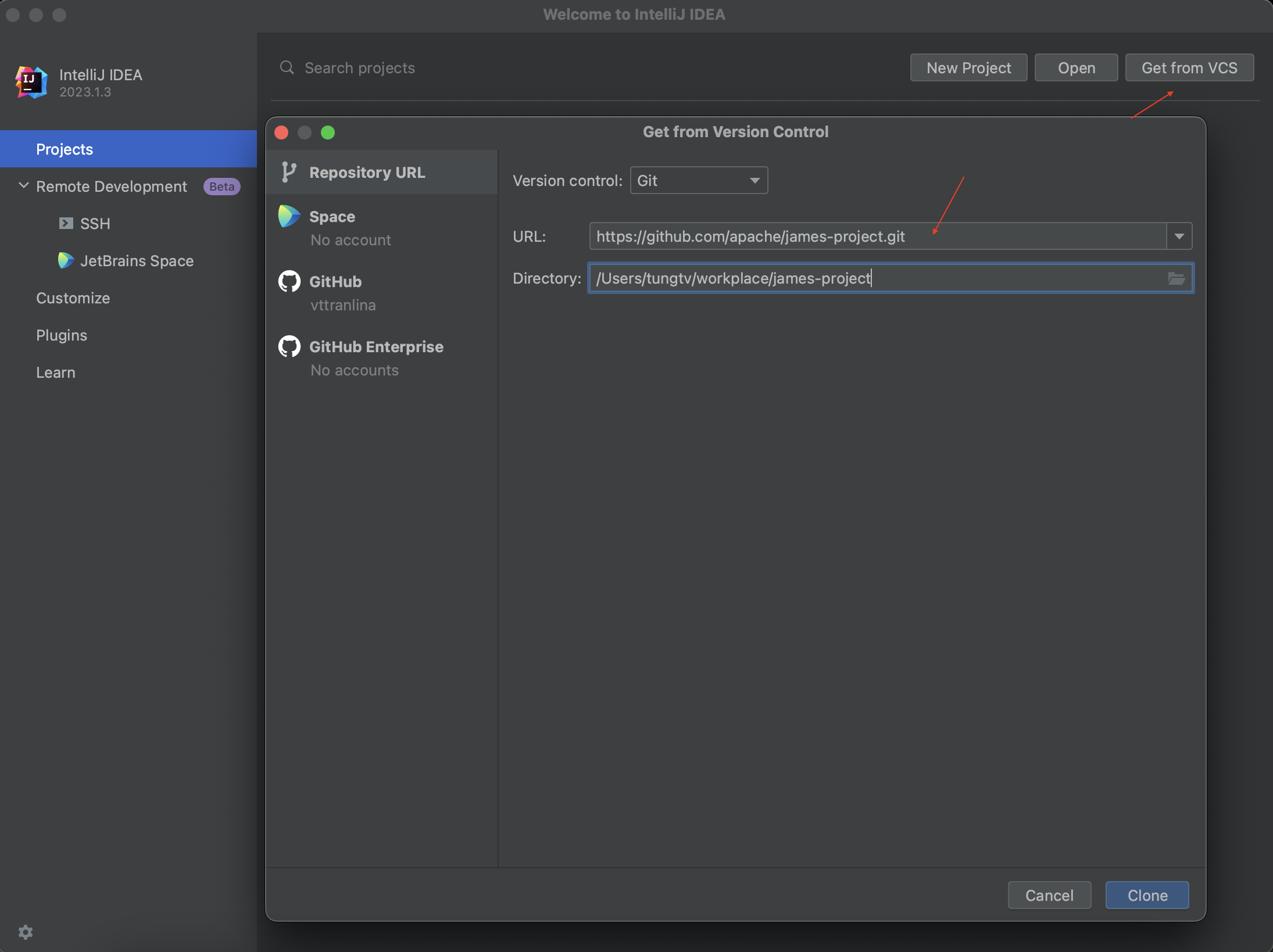
When this process is done, the project should look like this.
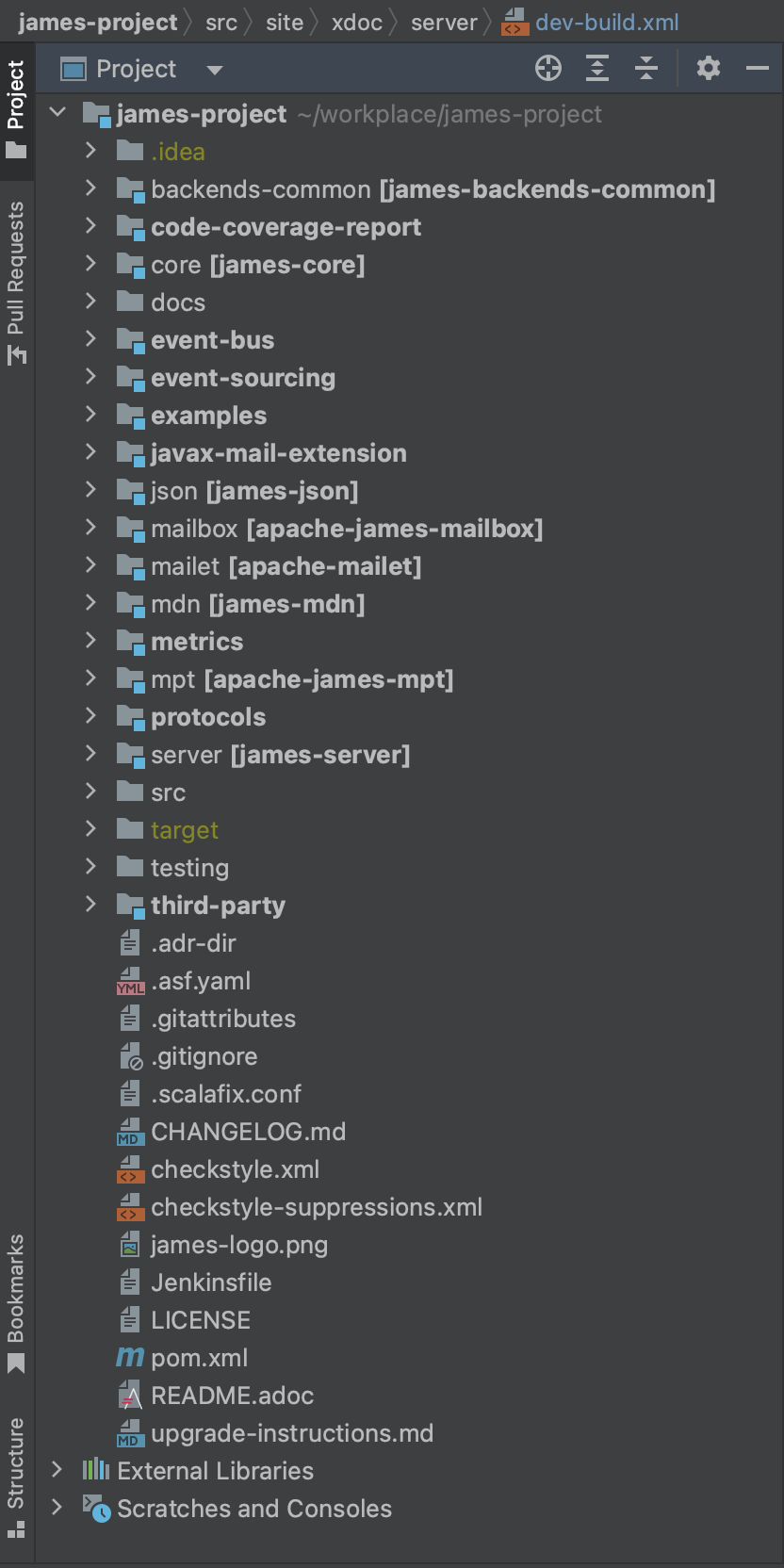
Building the project
To build the project, you must open the Maven Projects panel (should be the maven option in the upper right). Then double click on the package goal to run this goal.
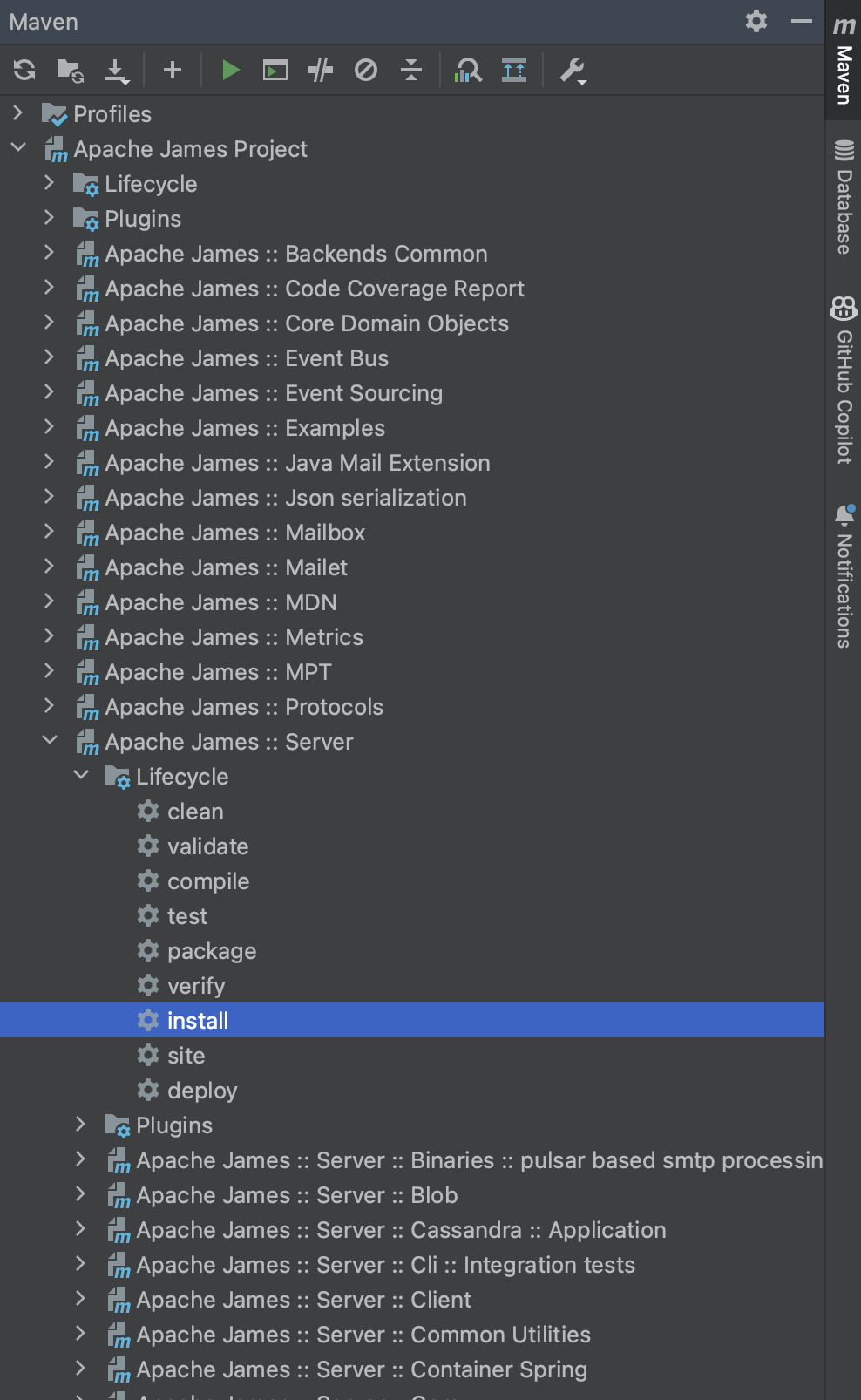
Then you will find the James server zip in the server/app/target folder.
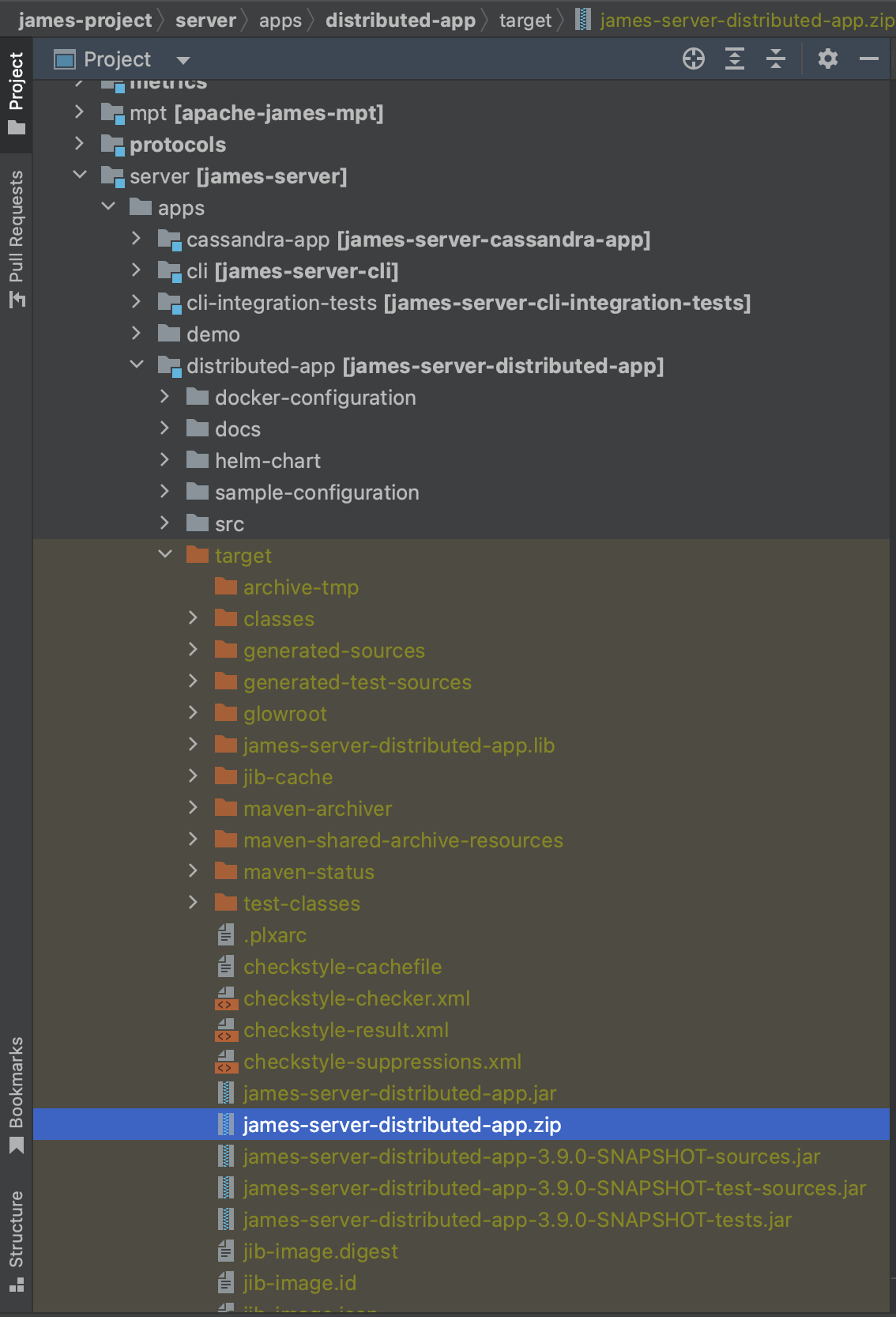
Note that tests can be long and can be skept by toggling skip test
IntelliJ IDEA plugins suggestion
We suggest you install these plugins for a better developing Apache James process:
- Scala: Some parts of the project are written in Scala.
- CheckStyle-IDEA: Better engage the project' check style constraints. (the `checkstyle.xml` file is already in root directory)
- AsciiDoc: Better manage our Antora documentations.
Import layout suggestion
We suggest you apply the import layout which is being used by the main contributors of the project so that
you can reduce import conflicts while developing the project.
- Java import layout:
import static all other imports
blank line
import java.*
blank line
import javax.*
blank line
import jakarta.*
blank line
import org.*
blank line
import com.*
blank line
import all other imports
blank line
- Scala import layout:
base package imports
blank line
java
blank line
all other imports
blank line
scala
To import Java layout, you can go to Settings > Editor > Code Style > Java. Then click to `Imports` tab, and
edit layout rule in `Import layout` section.
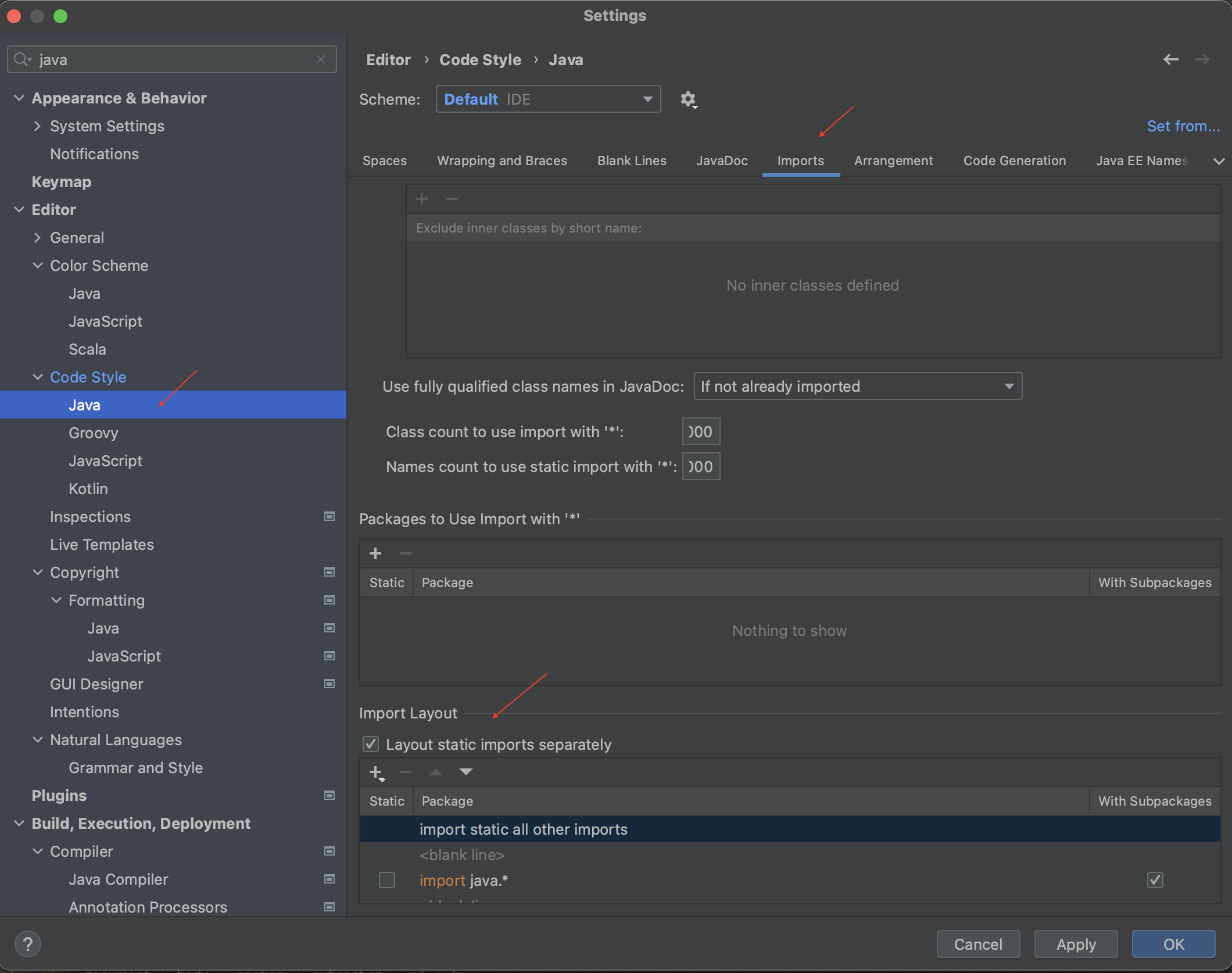
To import Scala layout, you can go to Settings > Editor > Code Style > Scala. Then click to `Imports` tab, and
edit layout rule in `Import layout` section.
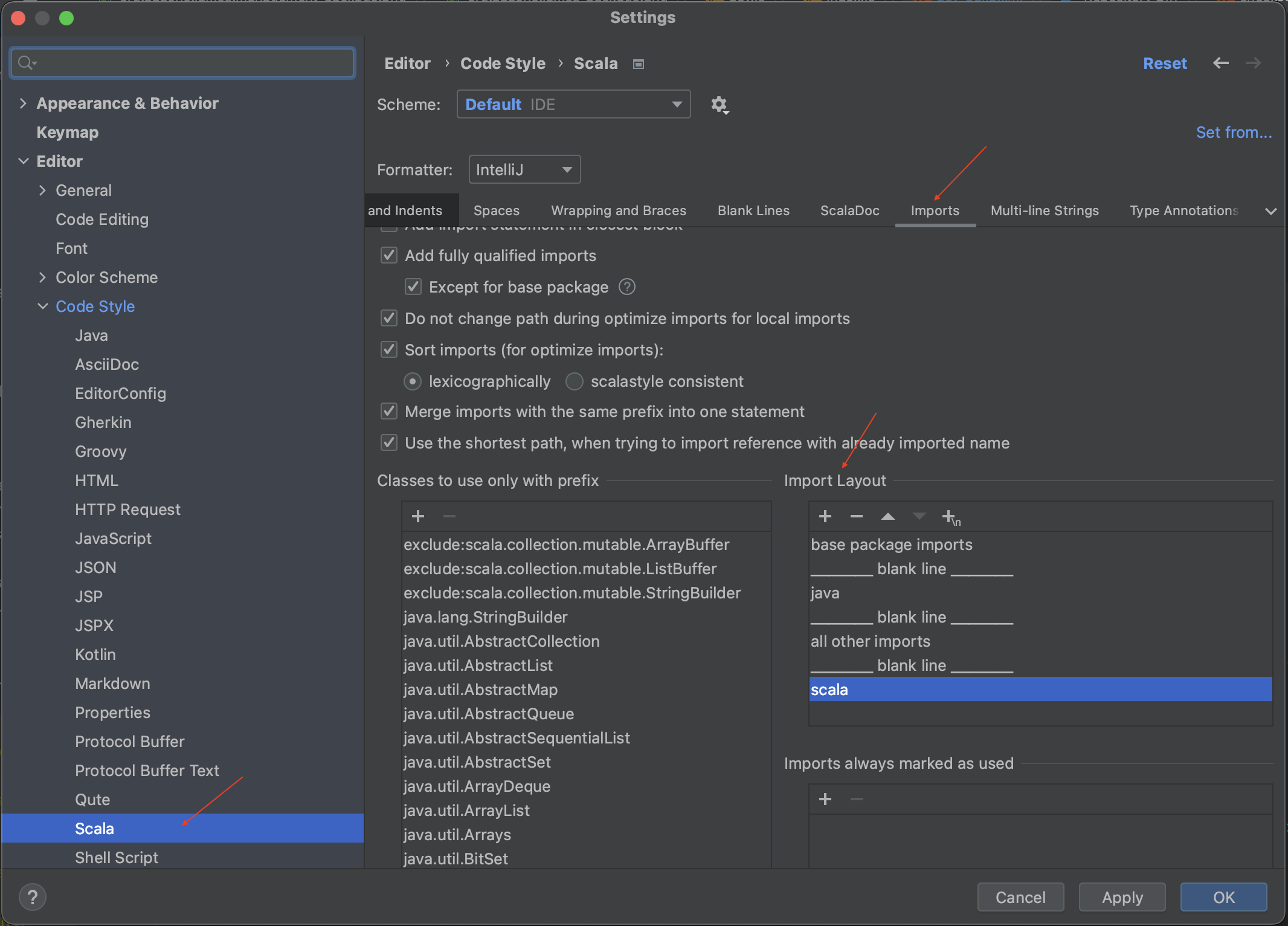
To use CheckStyle plugin, you can go to Settings > Tools > Checkstyle. Then click "+" button on Configuration File
section. The new window will be opened, and you need to input Description and file path to "checkstyle.xml"
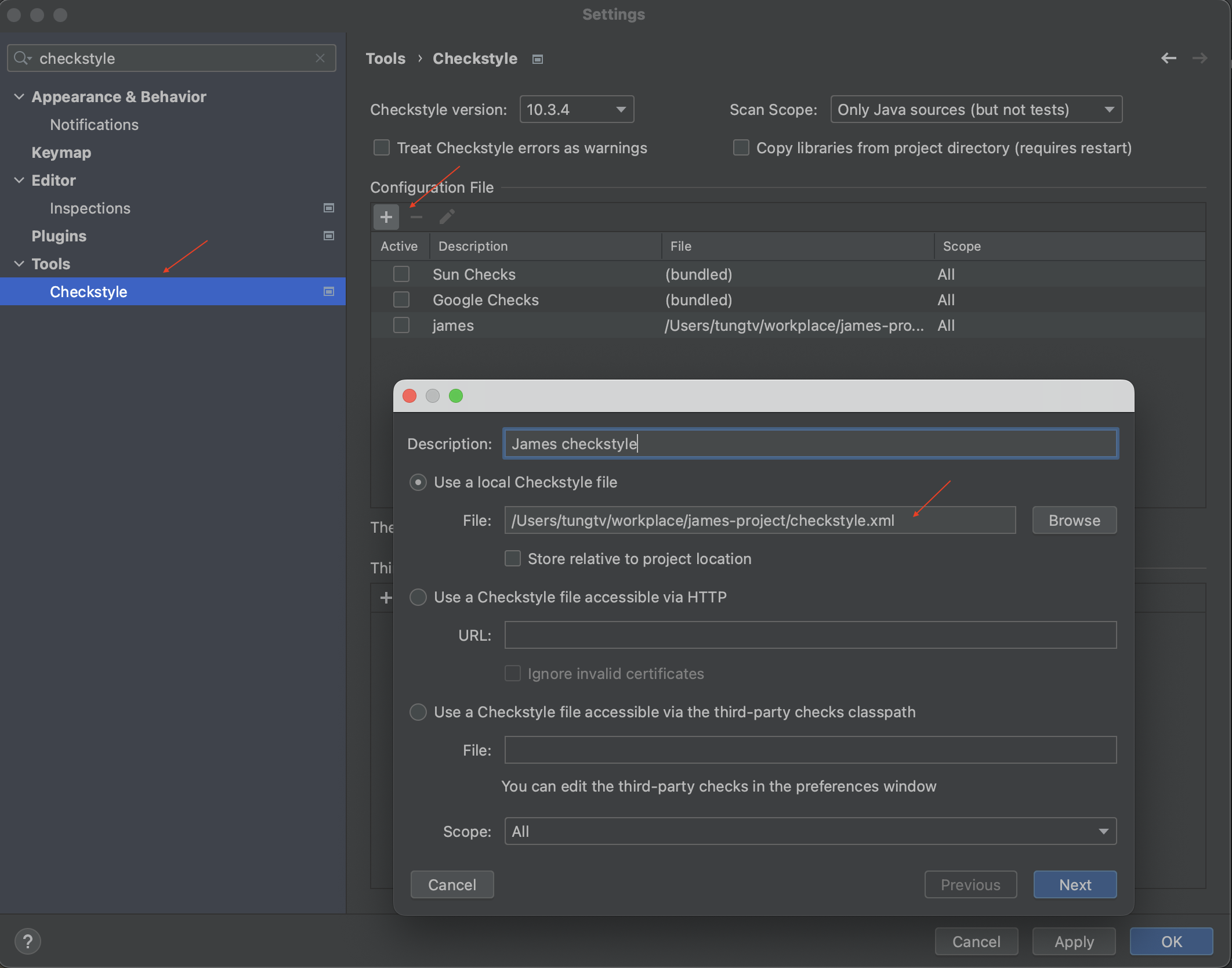
After declaring the CheckStyle rule, you can scan the source code to verify whether the current import layout is correct or not
by opening the CheckStyle plugin, and select James rule, then clicking on Check Current File or Check Module
or Check Project
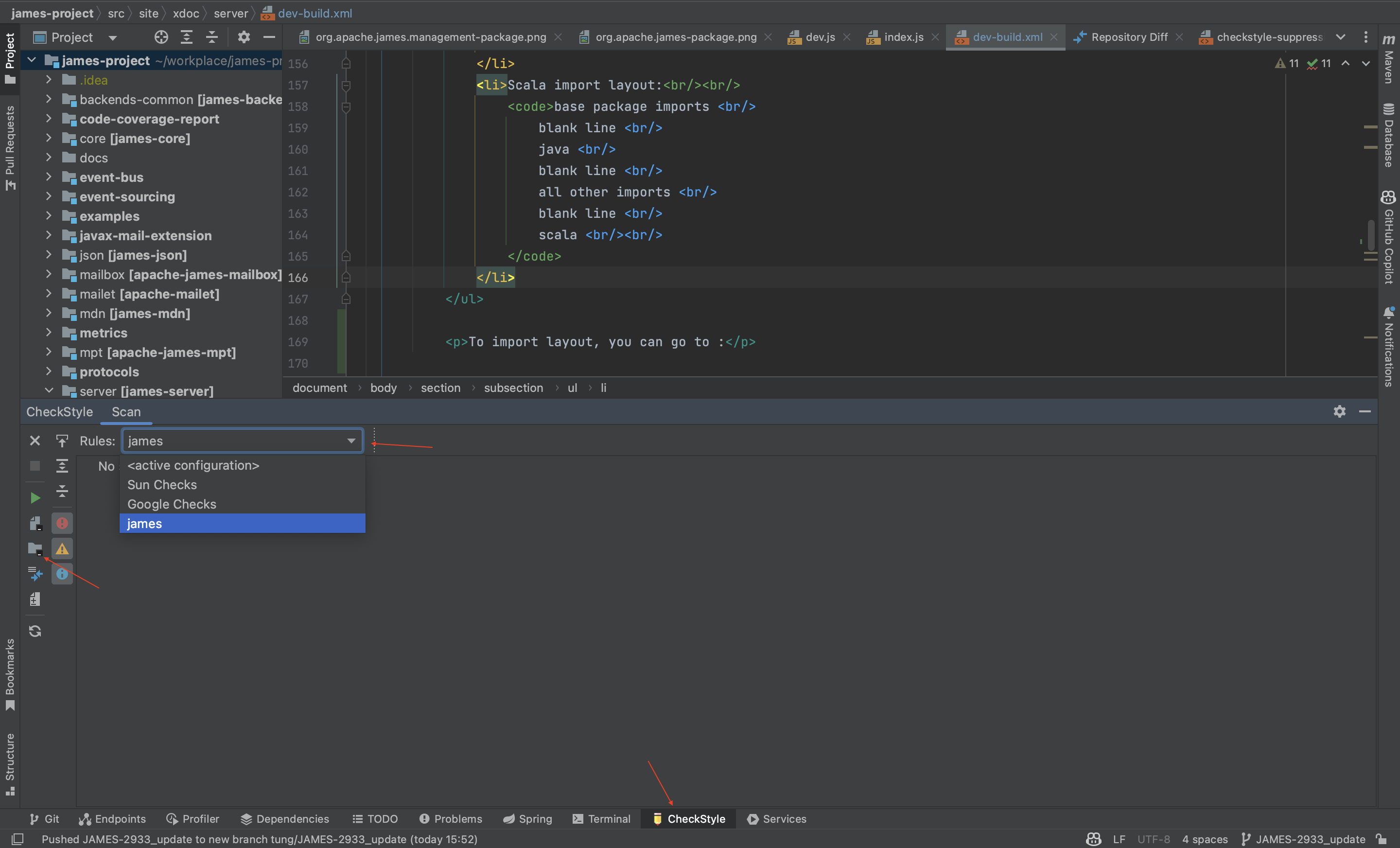
Build James Source from Eclipse
Warning: due to bad scala support in eclipse, we are not able to compile James with Eclipse. Contributions to
enhance the current situation are more than welcome.
Upon the following documentation, an interesting resource
can be found here
Import projects in Eclipse with m2eclipse
You should have Eclipse IDE with m2eclipse plugin installed.
You now need to import the maven projects in the Eclipse workspace.
Therefore, click on the File menu and select Import.
Choose Existing Maven Project and click on Next button.
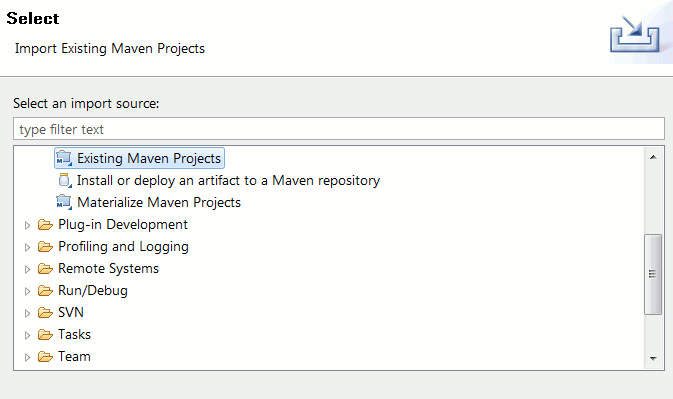
Select Projects to Import
Select the JAMES_SRC_HOME directory where you have checked out the source code.
Eclipse should present you with the list of James server modules.
Select the modules you want to import (by default, all) and click on Finish
to execute the import.
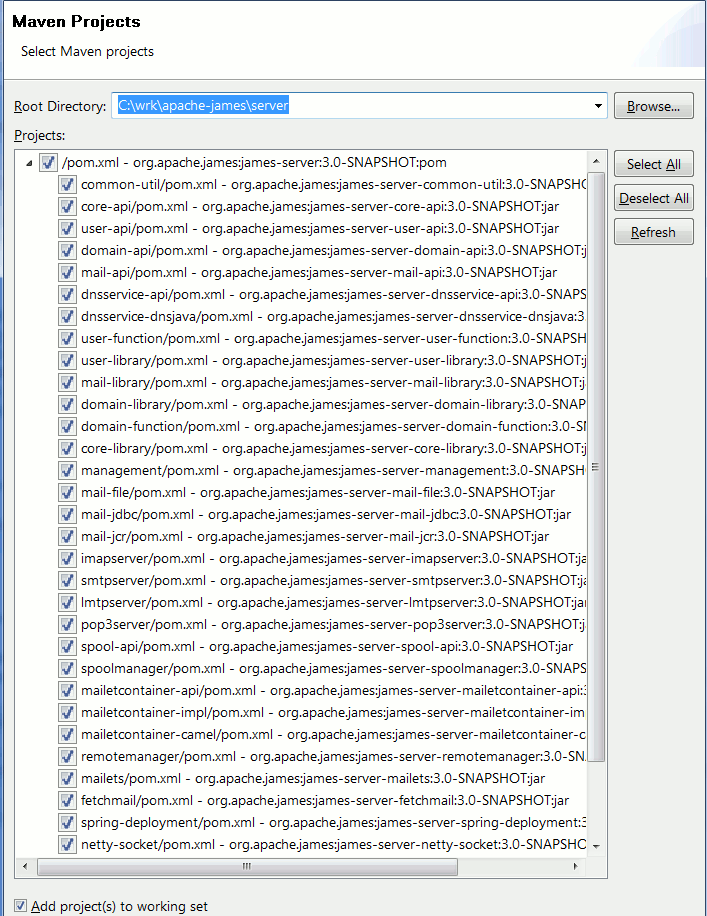
Enable Workspace Resolution
Check that 'Workspace resolution' is enable in m2eclipse plugin.
Your changes in code will be directly taken into account.
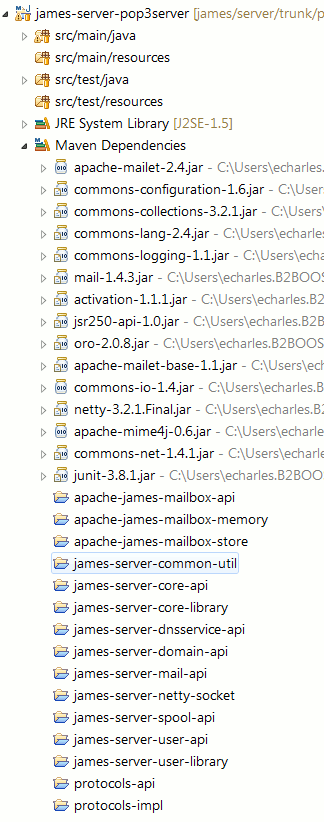
Prepare projects
Now you have James projects in Eclipse workspace.
You still have to prepare the following to be able to run from Eclipse:
- Copy the
context folder, log4j.properties
and META-INF folder from server/container/spring/src/main/config/james
directory to a source folder of james-server-spring project (you can use for example a
new folder called stage as Eclipse source folder).
- Copy all files (except context folder log4j.properties and META-INF/persistence.xml)
from
server/container/src/main/config/james folder to a conf folder
(conf folder must be a sub-folder of the JAMES_SRC_HOME directory where you made the check-out).
As non-root privilege user, you may need to change the SMTP/IMAP/POP3 ports to values higher than 1024.
- For ease, you can also create 2 new eclipse projects to edit the files and visualize the created mails/store/...:
james-server-container-spring-conf and james-server-container-spring-var.
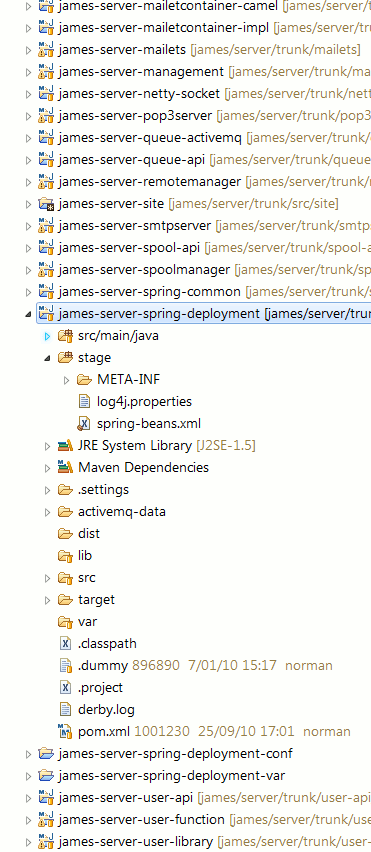
Run James from Eclipse
That's it. Run or Debug James in Eclipse (right-click on the Main class) and Have Fun!.
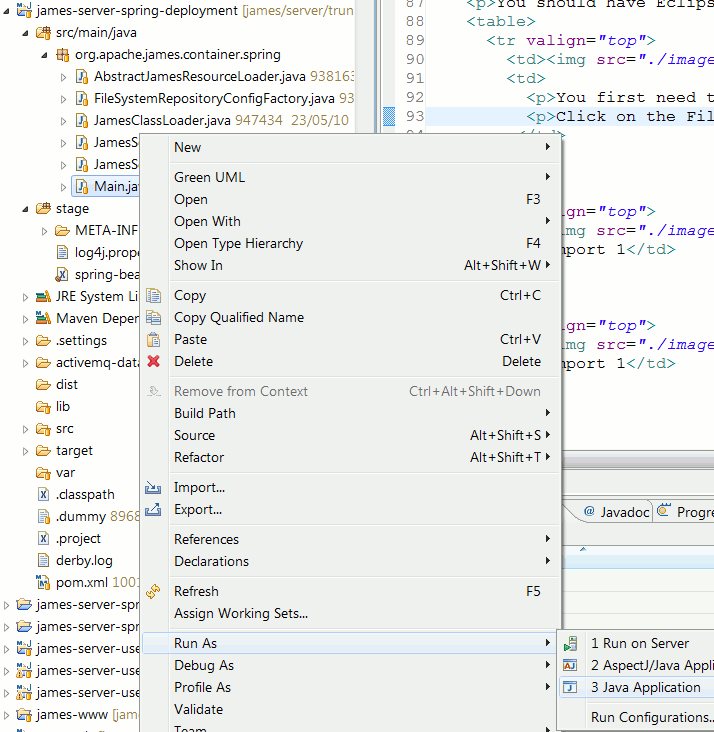
If you change a JPA Entity class, your will need to run 'mvn package'
or add the following option to the VM argument of your run configuration
'-javaagent:my_home_folder/.m2/repository/org/apache/openjpa/openjpa/4.1.1/openjpa-4.1.1.jar'
Build James from NetBeans
This was done using NetBeans 7, which comes bundled with Maven 3, needed to build James 3.
Older versions of NetBeans should be able to build James fine, provided that you configure them to use an instance of Maven 3, if they do not have it.
I used james 3.0-beta1 release and it builds in 7:40 min on my notebook running Debian Squeeze.
Getting the sources from the repository
Building James with NetBeans is very easy as it comes with Subversion and Maven support already build in.
Maven is bundled with the IDE, but Subversion is not, so you will have to install Subversion yourself and NetBeans will be able to use it.
You can get more details on how to install and where to get Subversion from the NetBeans Help menu by clicking on Help Contents and from there go to the IDE Basics->Version Control and File Hierarchy->Subversion topic.
For Linux users, Subversion is probably packaged by your distribution so use your distribution tools to install it (aptitude, yum, etc.)
Once you have Subversion, go to Team->Subversion->Checkout menu entry.
You will see an dialog window used to enter the information about the Subversion repository you are going to use. It looks like this:
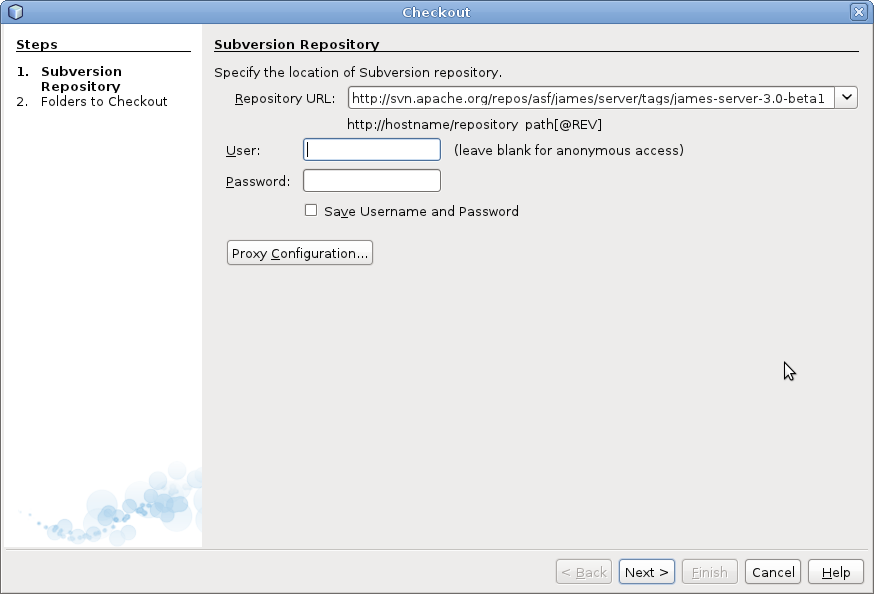
In the Repository URL field enter the location for James repository and click Next.
You can use the following URL to get the master or development version:
http://git-wip-us.apache.org/repos/asf/james-project.git.
After this you will be presented with another dialog window where you can configure which folders to check out and where to save them on your machine.
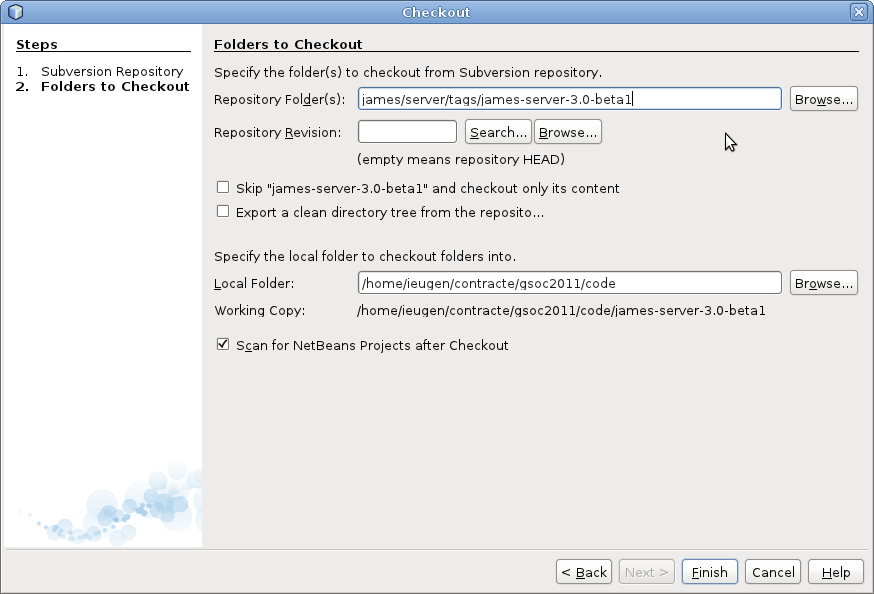
If you supplied the above URL you can click Finish to get master version and start hacking.
You can choose another folder by clicking Browse. A new dialog window will open and from there you can browse
the whole subversion repository. I wanted to build James 3.0beta so I choosed james-serve-3.0-beta1 under james/server/tags/ folder.
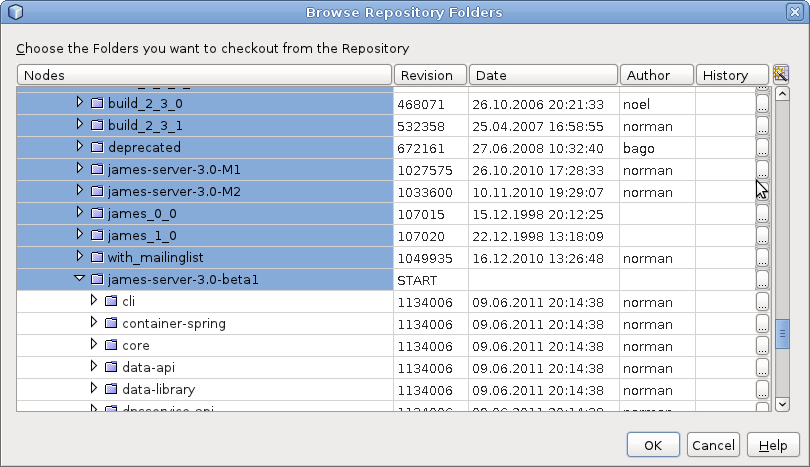
After you click Finish NetBeans will checkout the sources. It will detect the Maven project and ask you if you wish to open the project.
If you open the project you will see in the Projects Window (CTRL+1 if not visible) something similar to the next image:
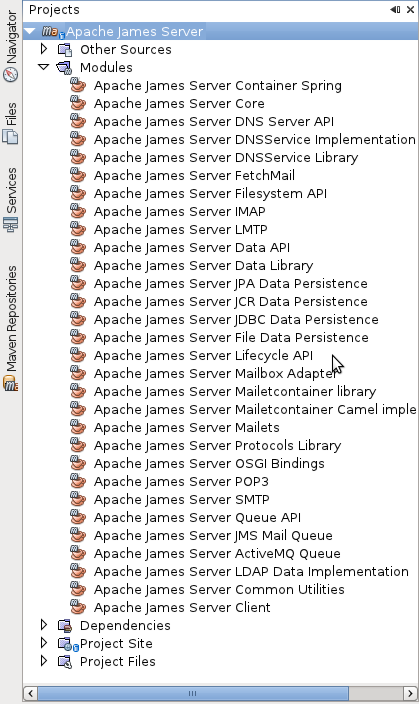
Building the project
Building the project does not require too much work. Just go to Run->Build Project menu option.
Make sure that James is the main project (if you have other projects open) or NetBeans will build that project instead of James.
Once the build is finished you will find the binary distribution in container-spring/target directory.
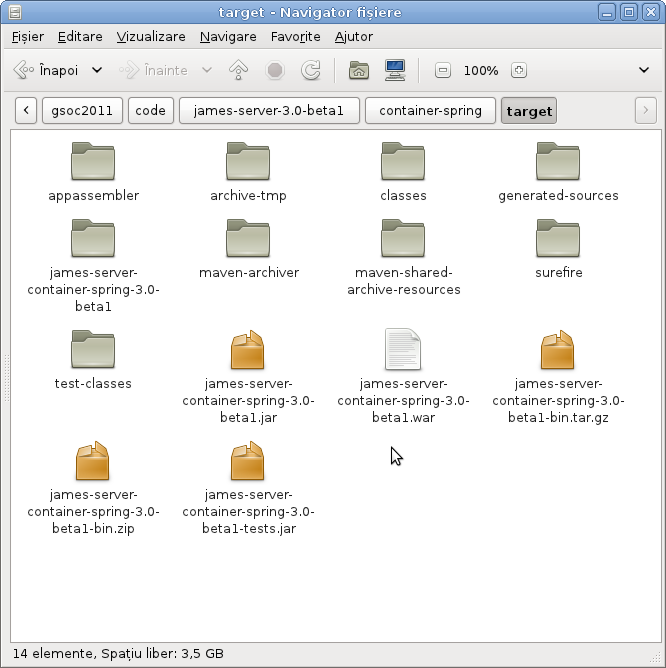
Build James Source from other IDEs
We will be happy to include on this page any other tutorial you could send
use about developing James with your favorite Integrated Development Environment.
 $dateFormat.applyPattern( $format )
$dateFormat.applyPattern( $format )
 $dateFormat.applyPattern( $format )
$dateFormat.applyPattern( $format )

















